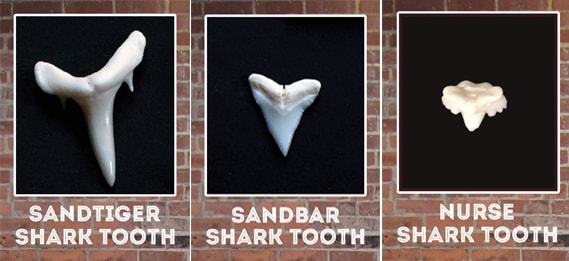Shark Teeth
Did you know that some shark species lose upwards of 30,000 teeth in their lifetime? Due to a strong bite and lack of a hard jawbone anchor, sharks’ teeth constantly break off or fall out. But do not worry! Sharks can have 5 to 15 rows of teeth. When a shark loses a tooth, a new one moves forward to fill in the empty spot. A shark’s first, or working, teeth are the largest. As you go back in its mouth, these teeth get smaller.
Like human teeth, shark teeth are made out of dentin. However, unlike ours, shark teeth are coated with a layer of cavity-preventing fluoride . . . so pass the candy!
Shark teeth come in a variety of shapes and sizes. Often the teeth their upper jaw are shaped differently than those in their lower jaw. The actual shape and structure of a shark’s teeth is related to the diet and hunting style of the species. For example, tiger sharks are known to eat sea turtles, seals and more or less anything that fits in their mouths, so they have large wide serrated teeth well suited to that varied diet. Meanwhile lemon sharks are primarily piscivores, or fish eaters, so their pointed rather than serrated teeth make it easier for them to grab fish and swallow them whole.
As a diver at the Greater Cleveland Aquarium, there are days when I find dozens of sandtiger, sandbar and nurse shark teeth. These three shark species have different types of teeth. The most visible of those belong to the sandtiger sharks. They have large, imposing and very sharp pointed teeth that jut out in all directions. Sandtigers can only eat things that fit within their mouths and swallow whole. Perfect for grabbing and holding prey, sandtigers use their teeth like the tines on a fork.
The smaller sandbar sharks have triangular teeth with serrated edges. They have teeth similar to a great white shark. These teeth allow sandbars to rip and cut food into bite-sized pieces.
Meanwhile, nurse sharks’ powerful jaws allow them to create suction and pull prey from hiding places in rocks and coral. Nurse sharks then use their dense and flattened teeth to crush their prey before swallowing, similar to the way humans use our molars to crunch and grind food. Their teeth are relatively small when compared to their body size.

The next time you visit the Aquarium and look up at that shark in the seatube you will know there is a lot more to a shark’s smile!
– Stephanie Q., Diver
